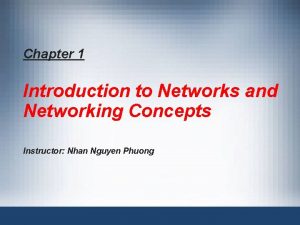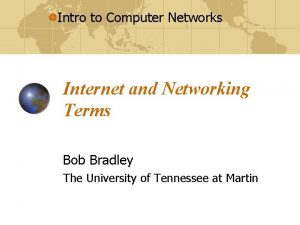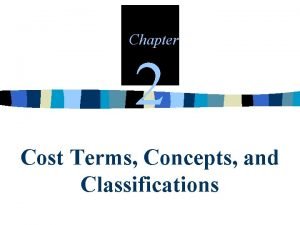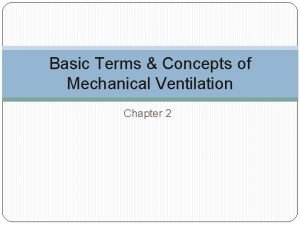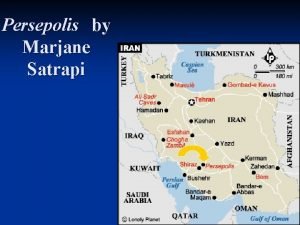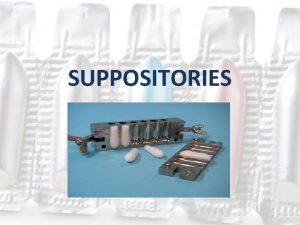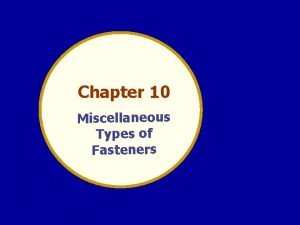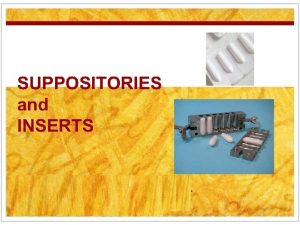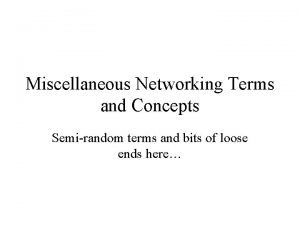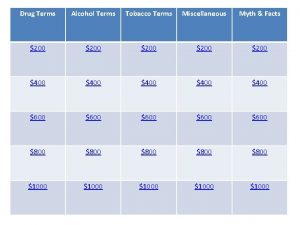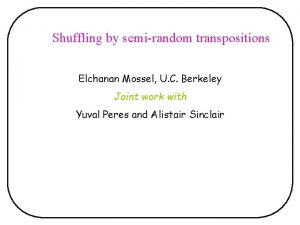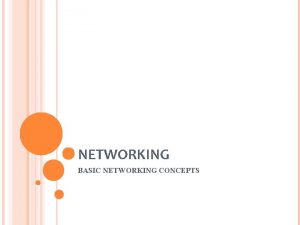Miscellaneous Networking Terms and Concepts Semirandom terms and











- Slides: 11

Miscellaneous Networking Terms and Concepts Semi-random terms and bits of loose ends here…

Various Terms • Symmetric or Asymmetric Protocol – There are several contexts for symmetry, but one is that symmetric refers to peer-to-peer communications, while asymmetry refers to client-server communications. • Octet – an octet is the same as a byte of data. Octet is used in the context of data transmission.

Connection-Oriented vs. Connectionless • Connection-oriented communication – Like a telephone call – Establish communications, transfer data, terminate connection – Reliable, but overhead required – E. g. TCP is a connection-oriented protocol • Connectionless communication – More like the post office without confirmation. Drop mail in the box, don’t really know if it’s delivered unless the recipient sends a reply and the reply is not lost – Faster, cheaper, but less reliable – E. g. UDP is a connectionless protocol

Connection-Oriented Protocol

Protocol Data Unit • PDU – Protocol Data Unit. – An encapsulated chunk of data referring to a specific protocol. – Related terms are packet and datagram. – Packet: Typically a PDU used in the context of connected-oriented protocols – Datagram: Typically a PDU used in the context of connection-less protocols.

Segmentation • As we have discussed, it is possible for data to be broken up into chunks, or segments, and transmitted individually. A couple reasons for segmentation are: – Network may only accept blocks of data of certain size. ATM only allows 53 bytes while Ethernet has a maximum of 1526 bytes. – Error control may be more efficient with smaller sizes. However, overhead and throughput will be affected. – Receiving entities may need smaller buffers. However, we might spend more time processing lots of little packets. – Equitable access for shared facilities

Ordered Delivery • Ordered Delivery refers to the PDU’s arriving in order, or at least being processed in order. • Generally we will want to process in order using connection-oriented protocols. – Packets may travel different routes through the network and arrive out of order – To re-order packets, we need a buffer to store received data and assign numbers to each packet. – Note that the max sequence number must be greater than the maximum number of outstanding packets.

Flow Control • Flow Control refers to a receiving entity being able to limit the rate of data a sender is transmitting. – For example, the sender is transmitting faster than the receiver can handle (and perhaps his buffer is getting full). • We’ll examine several techniques later, including stop-and-wait and sliding window techniques.

Addressing • Generally we need addresses at three layers: – Application address: Name (www. whatever), Port – Network address: IP Address – Data Link Address: Ethernet MAC • Within their scope, these addresses must be unique! • Different ways to use addresses: – Unicast addressing is a message directed to one particular destination. – Multicast addressing is a message directed to a specific subset of entities. – Broadcast addressing is a message directed to everyone.

Multiplexing • Different definitions for hardware and software • Hardware sense: we’ll cover shortly • Software sense: – Packets are sent in one jumbled stream. For example, two apps send data in one stream of packets. The source and destination apps are identified by port number. – Demultiplexing: Sorting the packets and sending them to the proper app on the receiving side. This is also done based on the port numbers stored in the packet.

Transmission Services • Finally, a protocol might provide extra services that are useful. A few of these are: – Priority. Given some messages higher priority to get through – Quality of Service. Guarantees on minimum throughput or minimum delay may be required for some applications – Security. Either restricting access or methods for maintaining privacy may be invoked
 Software defined networking vs traditional networking
Software defined networking vs traditional networking Networking basics concepts
Networking basics concepts Computer networking terms
Computer networking terms Testing tool in carpentry
Testing tool in carpentry Cost terms concepts and classifications
Cost terms concepts and classifications Transpulmonary pressure formula
Transpulmonary pressure formula Graphic novel terms and concepts
Graphic novel terms and concepts Type of suppository
Type of suppository Miscellaneous detail
Miscellaneous detail Miscellaneous fasteners
Miscellaneous fasteners Miscellaneous operators in javascript
Miscellaneous operators in javascript Miscellaneous base for suppositories
Miscellaneous base for suppositories

